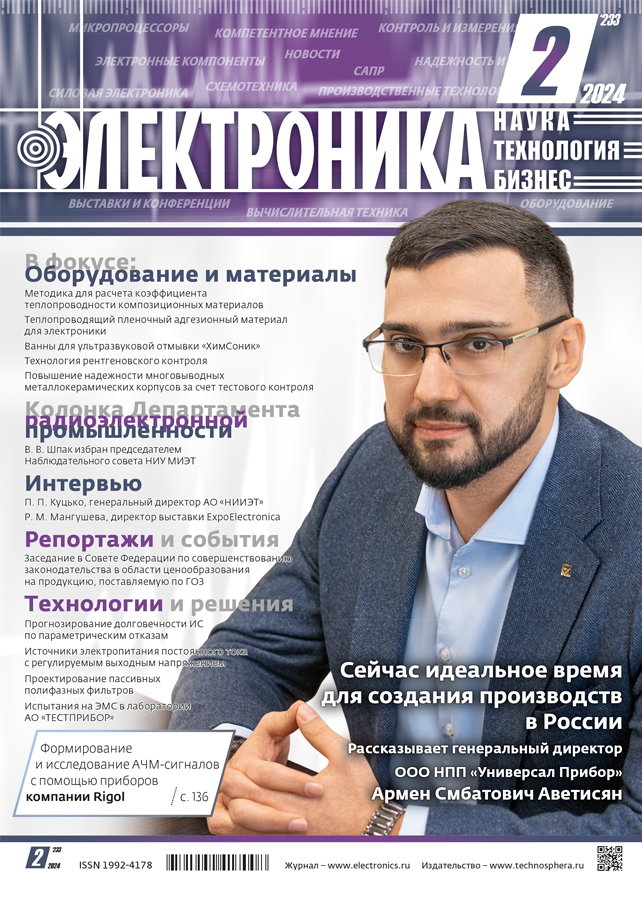Passive polyphase filters design methodology
- Autores: Nedashkovsky L.1,2, Repin V.1
-
Afiliações:
- АО «НИИМА «Прогресс»
- НИУ МИЭТ
- Edição: Nº 2 (2024)
- Páginas: 108-116
- Seção: Microwave electronics
- URL: https://journals.eco-vector.com/1992-4178/article/view/629560
- DOI: https://doi.org/10.22184/1992-4178.2024.233.2.108.116
- ID: 629560
Citar
Texto integral
Resumo
The article summarizes and systematizes the experience practice in the designing of passive polyphase filters – important components of microwave ICs, such as quadrature modulators, quadrature demodulators and phase shifters.
Palavras-chave
Texto integral
Sobre autores
L. Nedashkovsky
АО «НИИМА «Прогресс»; НИУ МИЭТ
Autor responsável pela correspondência
Email: leo_ned@mail.ru
ведущий инженер; ассистент
RússiaV. Repin
АО «НИИМА «Прогресс»
Email: leo_ned@mail.ru
начальник группы
RússiaBibliografia
- Zhang Z. Analysis, design and optimization of RF CMOS polyphase filters. Doctoral dissertation, Duisburg, Essen, Univ., Diss., 2005.
- Лосев В.В., Недашковский Л.В., Шабардин Р.С. Методика проектирования тракта гетеродина СВЧ квадратурных модуляторов и демодуляторов с регулируемым разбалансом // Электронная техника. Серия 3: Микроэлектроника. 2021. № 2 (182). С. 5–9.
- Хоровиц П. Искусство схемотехники / Пер. с англ. П. Хоровиц, У. Хилл. Изд. 2-е. М.: Издательство БИНОМ, 2015. 704 с.
- Hornak T. Using polyphase filters as image attenuators // RF Design, 2001.
- Sanderson D.I. A 5-6-GHz polyphase filter with tunable I/Q phase balance / D.I. Sanderson, R.M. Svitek, S. Raman // IEEE microwave and wireless components letters. 2004. V. 14. No. 7. PP. 364–366.
- Маркосян Е.С. Исследование характеристик несимметричных пассивных полифазных фильтров // Известия вузов. Электроника. 2002. Т. 1. № 2. С. 47–54.
- Калёнов А.Д., Недашковский Л.В. Исследование и разработка пассивного полифазного фильтра для работы в СВЧ-диапазоне // Микроэлектроника и информатика. 2017. Всероссийская межвузовская научно-техническая конференция студентов и аспирантов. М.: МИЭТ, 2017. С. 69.
Arquivos suplementares
Arquivos suplementares
Ação
1.
JATS XML
Baixar (39KB)
3.
Fig.2. Differences in the frequency response (a) and phase response (b) of a two-stage PFF with two connection options
Baixar (34KB)
4.
Fig.3. PFF cascading (a) and dependence of amplitude imbalance on frequency and number of cascades (b)
Baixar (41KB)
5.
Fig.4. The result of optimizing the PFF circuit for losses using parametric analysis with varying tuning coefficients
Baixar (360KB)
Baixar (268KB)
Baixar (1MB)
8.
Fig.7. Frequency response (a) and difference in phase response (b) PFF without taking into account parasitic elements (1), taking into account the parasitic elements of the “direct” topology (2) and taking into account the parasitic elements of the “circular” topology (3)
Baixar (34KB)
Baixar (40KB)
















